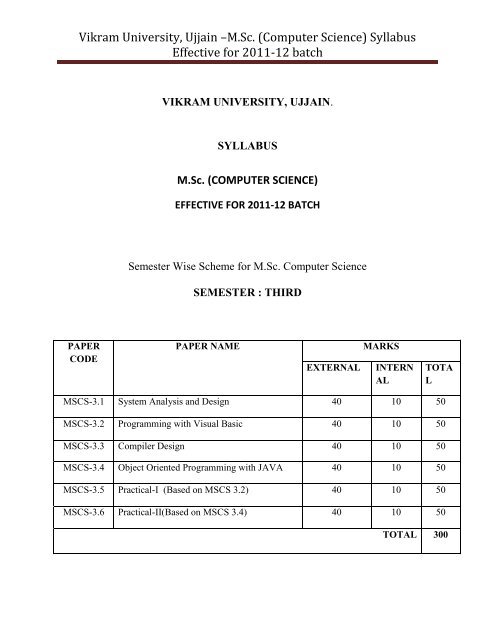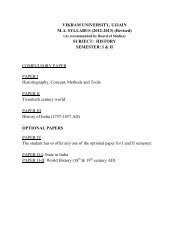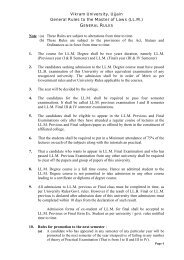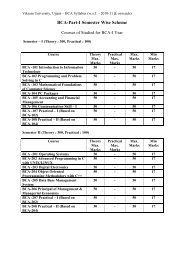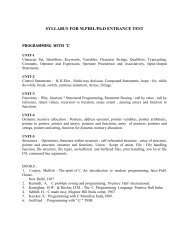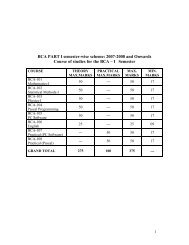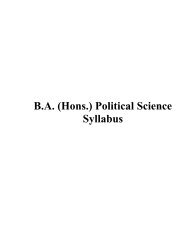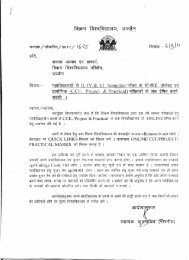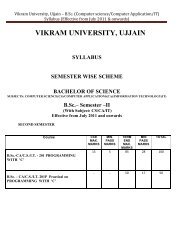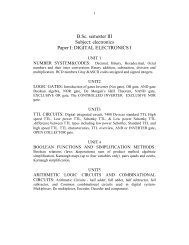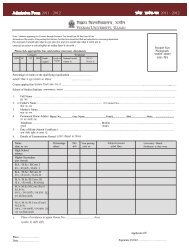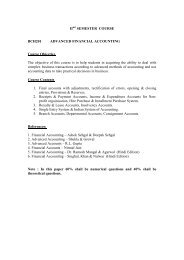Vikram University, Ujjain –M.Sc. (Computer Science) Syllabus ...
Vikram University, Ujjain –M.Sc. (Computer Science) Syllabus ...
Vikram University, Ujjain –M.Sc. (Computer Science) Syllabus ...
- No tags were found...
You also want an ePaper? Increase the reach of your titles
YUMPU automatically turns print PDFs into web optimized ePapers that Google loves.
<strong>Vikram</strong> <strong>University</strong>, <strong>Ujjain</strong> –M.<strong>Sc</strong>. (<strong>Computer</strong> <strong>Sc</strong>ience) <strong>Syllabus</strong>Effective for 2011-12 batchVIKRAM UNIVERSITY, UJJAIN.SYLLABUSM.<strong>Sc</strong>. (COMPUTER SCIENCE)EFFECTIVE FOR 2011-12 BATCHSemester Wise <strong>Sc</strong>heme for M.<strong>Sc</strong>. <strong>Computer</strong> <strong>Sc</strong>ienceSEMESTER : THIRDPAPERCODEPAPER NAMEEXTERNALMARKSINTERNALTOTALMSCS-3.1 System Analysis and Design 40 10 50MSCS-3.2 Programming with Visual Basic 40 10 50MSCS-3.3 Compiler Design 40 10 50MSCS-3.4 Object Oriented Programming with JAVA 40 10 50MSCS-3.5 Practical-I (Based on MSCS 3.2) 40 10 50MSCS-3.6 Practical-II(Based on MSCS 3.4) 40 10 50TOTAL 300
<strong>Vikram</strong> <strong>University</strong>, <strong>Ujjain</strong> –M.<strong>Sc</strong>. (<strong>Computer</strong> <strong>Sc</strong>ience) <strong>Syllabus</strong>Effective for 2011-12 batchMSCS 3.1 SYSTEMS ANALYSIS AND DESIGN [M.M. 40]UNIT-1Overview of system analysis and design, system development life cycle, project selection,feasibility analysis, design, implementation, testing and evaluation.UNIT-2Feasibility study- Technical and economical feasibility, cost and benefit analysis.UNIT-3System requirement specification and analysis: Fact finding techniques, Data flow diagrams, Datadictionaries, process organisation and interactions, decision analysis, decisin trees and tables.UNIT-4Detailed design- Modularisation, module specification, file design, system development involvingdata bases. System Control and Quality Assurance- reliability and maintenance, Software designand documentation tools, top-down ,bottom-up and variants. Units and integration testing,testing practices and plans. System controls , Audit trails.BOOKS:1. James,A.S.: Analysis of design of Information systems,Mcgraw Hill 1986.2. Ludeberg, M., Golkuhl, G. and hilsson,A. : Information systems development, Asystematisapproach, Prentice Hall international 1981.3. lesson,M.: System analysis and design, science research associates,19854. Sempriv,P.C.: System analysis-Definition Process and Design,19825. Richard,D.: System analysis design,Irwin Inc.1979.6. Awad,E. Homewood : System analysis and design,Awad,Irwin 1979.7. Lee, B.S. : Introducing System analysis and design 2 vols.Manchester UnitedKingdom, National computer centre,1978.8. Learn Youself : Systems analysis and design, Reston Publishing company,1975.9. Daniels : Practical System Design,Galgotia publ. Pvt. Ltd.
<strong>Vikram</strong> <strong>University</strong>, <strong>Ujjain</strong> –M.<strong>Sc</strong>. (<strong>Computer</strong> <strong>Sc</strong>ience) <strong>Syllabus</strong>Effective for 2011-12 batchMSCS 3.2 PROGRAMMING WITH VISUAL BASIC [M.M. 40]UNIT 1 :Basic of Visual Basic : The Integrated Development Environment : The Menu Bar, The Toolbars,TheProject Explorer, The Toolbox , The Properties Window, Your First/VB Project : Remaining and Savingthe Project. The Elements of the User Interface . Programming an Application : Programming thecommand Buttons, Grouping Controls. Visual Development and Events-Driven Programming : A Fewcommon Properties , A Few Common Methods, A Few Common Events .UNIT-2.Customizing the Environment : The Editor Tab, The Editor Format Tab, The General Tab, The DockingTab, The Environment Tab, The Advanced Tab. Visual Basic Projects : Building a Loan Calculator :Deciding How the Loan Application Works, Design the User Interface, Programming the LoanApplication, Validating the Data. Building a Math Calculator : Designing the User Interface,Programming the Math Application, Adding More Features, Error Trapping. A Project's Files : TheProject File, The Form File, Moving and Copying Projects, Executable files.UNIT - 3Visual Basic : The Language. Variables : Declaring Variables, converting Variable Types, User-Defined Data Types, Special Values, Examining Variable Types, Forcing Variable Declarations, AVariable Declarations, A Variable's <strong>Sc</strong>ope The Lifetime of a Variable. Constants . Arrys :Declaring Arrays, Specifying Limits, Multidimensional Arrays, Dynamic Arrays, Arrays of Arrays.UNIT - 4.Procedures : Subroutines, Functions , Calling Procedures Arguments : Argument-Passing Mechanisms,Using Optional Arguments, Passing an Unknown Number of Arguments, Named Arguments.Function Return Values : Functions Returning Custom Data Types, Functions Return Values Controlflow Statements : If ... Then, If ... Then ... Else , Select Case, Loop Statements : Do Loop, For Next,While Wend, Nested Control Structures, The Exit Statement.Working with Forms : An Application with Multiple Forms : The Startup Object The Appearance ofForms : The Start-Up Form, Loading, Showing, and Hiding Forms, Controlling One Form from withinAnother. Designing Menus : The Menu Editor, Programming Menu Commands, Building Dynamicforms at Runtime Drag-and-Drop Operations : The DragMode Property , TheDrag-Drop and DragOverMethods.Text Book : Mastering in Visual Basic 6
<strong>Vikram</strong> <strong>University</strong>, <strong>Ujjain</strong> –M.<strong>Sc</strong>. (<strong>Computer</strong> <strong>Sc</strong>ience) <strong>Syllabus</strong>Effective for 2011-12 batchMSCS 3.3 THEORY OF COMPILER DESIGN [M.M. 40]UNIT-1Structure of a compiler, cross compiler, finite automata and lexical analysis : The roll of lexicalanalyzer ,design of lexical analyzer.UNIT-2Regular expressions, finite automata, definite finite automata minimizing the no. of states of a DFA,context free grammers.UNIT-3Derivations and parse trees, basic parsing techniques, parses, shift -reduce parsing , operator precedence,parsing, top-down parsing.UNIT-4Run-time Storage administrations, implementation of a simple stack, allocation scheme.Implementation of block structured languages, storage allocation in block, structured languages, codegenerator.BOOKS :1 Aho, ullman : Principles of compiler design.
<strong>Vikram</strong> <strong>University</strong>, <strong>Ujjain</strong> –M.<strong>Sc</strong>. (<strong>Computer</strong> <strong>Sc</strong>ience) <strong>Syllabus</strong>Effective for 2011-12 batchMSCS-3.4 Object-Oriented Programming With Java [M.M. 40]UNIT -1Java Evolution, Overview of Java Language : Java Program Structure, Java Tokens, Java Statements, JavaVirtual Machine, Command Line Arguments. Constants, Variables and Data Types : Constants,Variables, Data Types, <strong>Sc</strong>ope of Variables, Symbolic Constants, Type Casting. Operators : Arithmetic,Relational, Logical, Assignment, Increment & Decrement, Conditional, Bitwise, Special Operators,Arithmetic Expressions, Evaluation of Expressions, Type Conversions in Expressions, OperatorPrecedence and Associativity, Mathematical Functions.UNIT -2Control Statements : Java’s Selection Statements : If, Switch. Iterative Statements : While, Do-while, For,Some for loop variations, Nested Loops. Jump Statements : Using breaks, Using continue, return.Classes, Objects and Methods : Class Fundamentals, Declaring Objects, Assigning Object ReferenceVariables, Introducing Methods, Constructors, Visibility Control, The this Keyword, GarbageCollection, Overloading Methods, Recursion. Arrays, Strings and Vectors.UNIT -3Inheritance : Inheritance basics, Using super, Creating Multilevel Hierarchy, Method Overriding,Dynamic Method Dispatch, Using Abstract Classes, Using final with Inheritance, The Object Class.Packages and Interfaces : Java API Packages, Using System Packages, Creating & Accessing Packages,Hiding Classes, Access Protection, Importing Packages, Interfaces : Defining, Implementing, ApplyingInterfaces, Variables in Interfaces. Exception Handling: Exception-Handling Fundamentals, ExceptionTypes, Uncaught Exception, Using try and catch, Multiple catch Clause, Nested try Statements, throw,throws, finally, Java’s Built-in Exceptions. Multithreaded Programming: Creating Threads, Extendingthe Thread Class, Stopping and Blocking a Thread.UNIT -4Applet Programming : Preparing to write Applets, Building Applet Code, Applet Life Cycle, Creating andExecutable Applet, Designing a Web Page, Applet Tag, Adding Applet to HTML File, Running theApplet, Passing parameters to Applet, Aligning the Display, Displaying Numerical values, Getting inputfrom the User.JDBC Connection and Implementation, Server side programming using Servlet and JSP.Text Books1. JAVA: The Complete Reference, Third Edition, P. Naughton & H. <strong>Sc</strong>hildt, Tata McGraw Hill.2. Programming with Java, Second Edition, E. Balagurusamy, Tata McGraw-HillReference Books1. Teach Yourself JAVA, Joseph O'Neil & Herb <strong>Sc</strong>hildt, McGraw-Hill.2. Object Oriented Programming with C++ and JAVA, D. Samanta, Prentice-Hall3. An Introduction to Java Programming, Daniel Liang Y, Prentice-Hall India.4. Developing Java Servlets, James Goodwill, Techmedia.5. Java Server Programming, Karl Avedal and Richard Browlet, J2EE Edition (Vol.-I)


